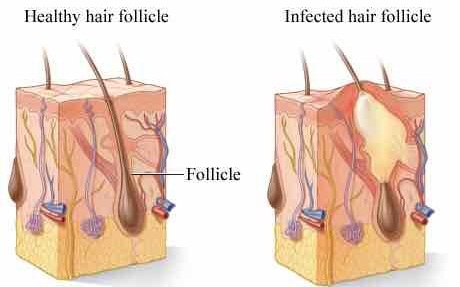
It’s painful, it’s embarrassing, and it can even be dangerous. Ingrown pubic hairs are common, but it’s not something most people want to talk about. So what causes these irritating sores, how should you treat them, and how can you prevent them?
Causes and Symptoms of Ingrown Pubic Hairs
An ingrown hair occurs when a hair grows at an awkward angle and either curls backwards into the skin or grows sideways and the tip reenters the skin. It is often caused by shaving or friction from tight fitting clothes.
The first symptoms you’ll probably notice are pain and itching in the area where the ingrown hair has developed. There may be swelling and a pustule that looks like a blood blister around the ingrown hair may form. Also surrounding the ingrown hair purple bumps (sometimes white) containing fluid could be noticed and swelling can range anywhere from a tiny bulge to a large nodule.
Treating an Ingrown Pubic Hair
If you have not developed a serious infection at the site of the hair (symptoms would be inflammation, heat, tenderness, and puss formation), you can try treating the ingrown hair at home. It is usually successful.
Soak the area with a hot compress for 10-15 minutes or soak in a hot bath. The heat and moisture will soften the skin and make the hair easier to remove. It has also been suggested that using depilatories designed for use in this area is also a good way to soften the skin and make removal of the hair easier.
Now that you have softened the region, use tweezers that have been rubbed with alcohol and remove the hair by gently lifting it up and out. Immediately apply a topical antibacterial cream to the affected area. Continue applying the cream at least twice a day for the next several days.
If the infection is advanced and the swelling large, consider seeing a doctor to resolve the problem. He may find it necessary to cut and drain the growth and may prescribe antibiotics to fight the infection.
How to Prevent Ingrown Pubic Hairs
One of the most effective ways to prevent deep ingrown pubic hairs is to practice proper hair removal. First, exfoliate the area you plan on shaving by using a soft washcloth and gently scrubbing the area for few minutes. Then sit back and relax in a warm tub for 10 or 15 minutes. Use a new razor and a shaving cream designated for sensitive areas. Always shave in the direction of the growth of the hair. Shaving in the other direction encourages the development of ingrown hairs.
Friction from wearing tight clothing can also increase the occurrence of ingrown hairs, purple bumps, and pustules. Tight jeans, pants, and panties are especially prone to causing deep ingrown pubic hairs.